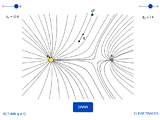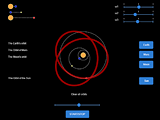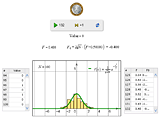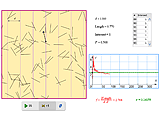TYPOLOGY OF OUR EDUCATIONAL MODELS
2. Explore
3. Construct
4. Solve and Check
5. In Place of a Teacher
6. Virtual Experiments
6. Virtual Experiments
Virtual experiments are another interesting type of models useful in studying the processes and phenomena that emerge in physics, astronomy, biology, chemistry, ecology, and just in real life. Such a model allows us not only to give a mathematical description of a phenomenon in the form of various geometric and functional relationships, but also to represent it visually by showing, the dynamics of its behavior on the screen in real time.
For basic level of learning it is reasonable to use ready-made models of virtual experiments, which involve observation, collection and processing of data, and detection of main relationships. On advanced level, the focus is shifted to the creation of MathKit models by students themselves on the basis of the notions they learned studying specific subjects.
![]()
6.1. Virtual Experiments in Physics
It is known well that physical experiments are often quite pricey, both in terms of the time spent to run them and in terms of the required equipment. Computer model allows us to walk around these issues. In the model given below one can see the motion of a test charge along lines of force of the field created by an arbitrary system of charged particles. Moreover, we can change the numeric values of the charges and their position, getting both well-known and new configurations.
 |
A Point Charge |
![]()
6.2. Virtual Experiments in Astronomy
Astronomical models provide a workspace for experiments on the scale of the Solar System and even the entire universe. The model we present shows thee real trajectories of the Solar System planets including what is called retrograde motion, but also allows you to define your own planetary system by specifying the parameters of planetary motion of your choice.
 |
The Orbits of the Planets |
![]()
6.3. Stochastic Processes
As an aid in studying stochastic processes, MathKit provides a set of tools for their simulation, as well as for gathering and processing the statistical data thus obtained. Even the simplest coin-tossing experiment demonstrates the action of the Law of Large Numbers and allows us to estimate the deviation of the frequency from the probability to make sure of the validity of the De Moivre-Laplace Theorem.
 |
Flipping a Coin |
![]()
6.4. Mathematics and Experiment
Mathematics itself also provides examples of interesting experiments. For example, more than 300 years ago the French naturalist and mathematician George-Louis de Buffon came up with the idea of a statistical experiment that leads to an approximation for the number π by means of tossing a needle onto a sheet of lined paper. The model below reproduces Buffon’s experiment and its generalization, in which the needle is replaced by an arbitrary curve.
 |
Buffon's Needle |
|
|
TYPOLOGY OF EDUCATIONAL MODELS | |